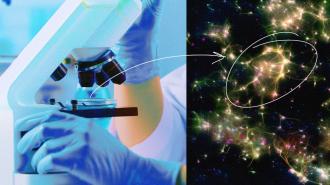Australian military is funding a computer chip merged with human brain cells
This article is an installment of Future Explored, a weekly guide to world-changing technology. You can get stories like this one straight to your inbox every Thursday morning by subscribing here.
The Australian military is funding a project to grow intelligent “mini-brains” in petri dishes. The goal is to use these “DishBrains” to design better AIs — and, eventually, even combine the two, creating AIs merged with processing features of human brain cells.
DishBrain
By creating just the right conditions, scientists can coax stem cells into growing into “organoids,” three-dimensional tissues that resemble the structure and function of different organs — even brains.
These are nowhere near as large or sophisticated as actual brains, but they do contain neurons that can send electrical signals to one another, which has made them useful for brain research in healthcare.
For example, German scientists recently discovered a potentially better way to treat the deadly brain disease herpes encephalitis by infecting brain organoids with the HSV-1 virus.
Brain organoids are tiny clumps of cells that resemble the structure and function of the brain.
In 2022, researchers at Monash University in Australia did something unprecedented with brain organoids: they got the clumps of cells to demonstrate something resembling intelligence.
To do that, they grew human brain cells on top of a microelectrode array — these are the same devices used in some brain implants to send or receive neural signals.
They then trained their brain organoids to play Pong, the tennis-like computer game where players move paddles up and down to intercept the path of a bouncing ball.
This was done by stimulating electrodes in certain parts of the array to indicate the path of the ball and the location of the paddle. The brain organoid could then produce signals that stimulated certain electrodes to move the paddle up or down.

To train the system, the researchers had to get creative.
Unlike animals, which can be easily rewarded for learning, you can’t give a clump of neurons a treat. Instead, the researchers “motivated” the cells by taking advantage of something called the “free energy principle.”
This theory is based on the idea that the brain will use what it knows about its environment to make predictions likely to minimize disorder. As it learns more, it gets better at making the right predictions, and if its environment changes, it’ll adjust its predictions.
“What digital models try and emulate, we begin with.”
Cortical Labs
For their Pong-playing DishBrain, the researchers stimulated the organoid in a predictable way — the same voltage for the same period of time across all of the electrodes — when the ball made contact with its paddle.
They also stimulated it in an unpredictable way, by firing random electrodes, if it let the ball get past its paddle.
During the study, the brain organoids that received this stimulation displayed a “significant increase” in the average amount of time they could go before missing a ball. Organoids that didn’t receive such stimulation displayed no increase.
“We have shown we can interact with living biological neurons in such a way that compels them to modify their activity, leading to something that resembles intelligence,” said lead author Brett Kagan, who is also the CSO of biotech startup Cortical Labs.
What’s next?
In July 2023, Monash University and Cortical Labs announced that they had secured nearly $400,000 USD ($600,000 AUD) to further research their DishBrains through Australia’s National Intelligence and Security Discovery Research Grants program.
The goal of the study will be to look for solutions to a problem that affects AI algorithms but not human brains: catastrophic forgetting.
“The brain is still unmatched by modern computers.”
Thomas Hartung
While people can learn one thing and then retain that knowledge when they learn something else, the same isn’t true for AIs — they often “forget” previously learned information when taught something new.
Overcoming this issue and creating systems capable of continual learning — the kind that comes easily to us — could lead to the development of AIs that get smarter and more capable the longer they exist.
With the new funding, the Monash team will try to identify the biological mechanisms behind continual learning in their DishBrains and then attempt to replicate those mechanisms in AIs.
“We will be using this grant to develop better AI machines that replicate the learning capacity of these biological neural networks,” said lead researcher Adeel Razi.
Building better AIs is just the short-term goal, though.
Eventually, the researchers want to replace traditional silicon computer chips with intelligent organoids to create advanced biocomputers. AIs could then be built on top of the same foundation as the human brain, making them more efficient and flexible.
“The human neuron is self-programming, infinitely flexible, the result of four billion years of evolution,” Kagan’s startup Cortical writes on its website. “What digital models try and emulate, we begin with.”
The big picture
In February 2023, Kagan co-authored a paper in Frontiers in Science that gave a name to this new concept of merging mini-brains and computers — “organoid intelligence” — and detailed the ways it could revolutionize technology.
However, this field is still incredibly new, and many hurdles stand between researchers and their vision of continually learning AIs. One major hurdle: the need to scale up the number of cells in a brain organoid.
“[Existing brain organoids] are too small, each containing about 50,000 cells,” Thomas Hartung — a toxicologist at Johns Hopkins University and a co-author of the Frontier’s paper — told CNN. “For [organoid intelligence], we would need to increase this number to 10 million.”
Figuring out how to give brain organoids robust vascular networks could help overcome the size issue, but we also need to increase the complexity of the models so that they more closely resemble our brains.
According to Hartung, it might be decades before anyone can create a system with the brain power of a mouse, but if researchers are eventually able to deliver on the promise of organoid intelligence, the world will never be the same.
“The brain is still unmatched by modern computers,” he said. “Frontier, the latest supercomputer in Kentucky, is a $600 million, 6,800-square-feet installation. Only in June of last year, it exceeded for the first time the computational capacity of a single human brain — but using a million times more energy.”
We’d love to hear from you! If you have a comment about this article or if you have a tip for a future Freethink story, please email us at [email protected].





